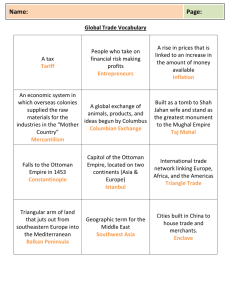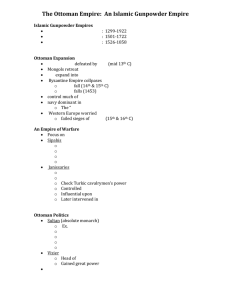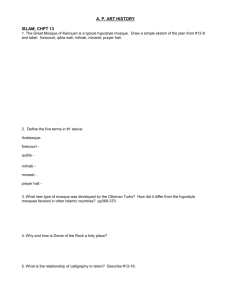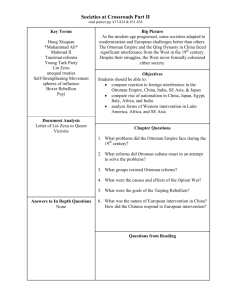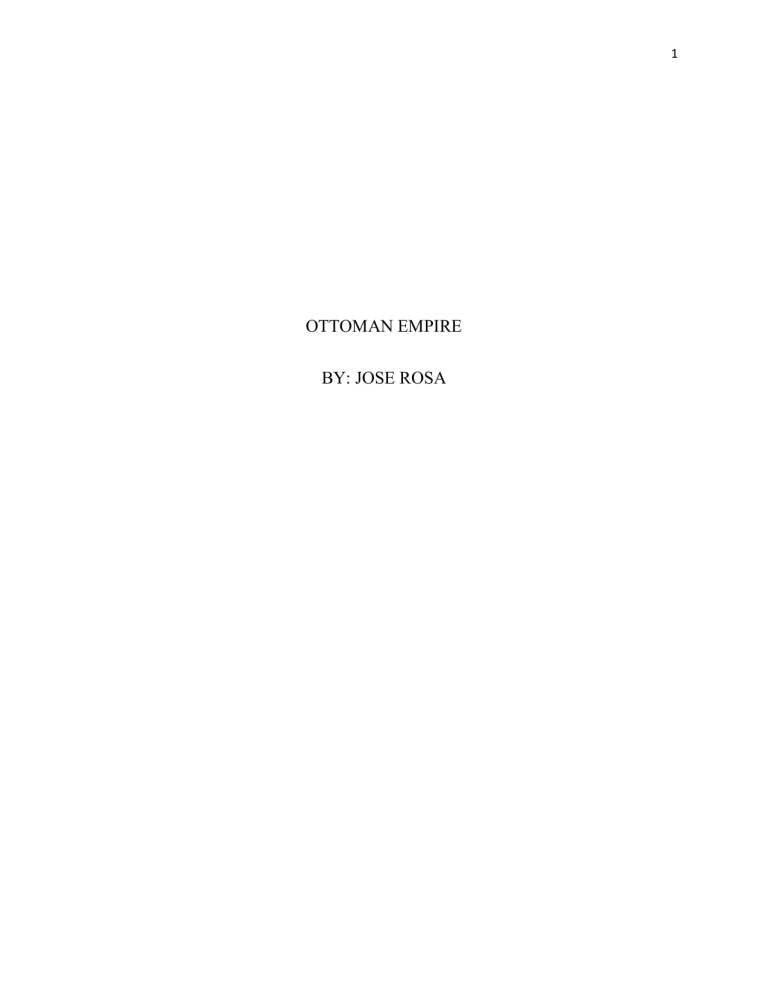
1 OTTOMAN EMPIRE BY: JOSE ROSA 2 One of the most powerful and enduring dynasties in human history was the Ottoman Empire. For more over 600 years, this Islamic superpower reigned over sizable portions of the Middle East, Eastern Europe, and North Africa. The Sultan, the nation's supreme leader, was granted complete religious and political control over his people. Many historians regarded the Ottoman Empire as a source of tremendous regional peace and security as well as significant accomplishments in the arts, science, religion, and culture, but Western Europeans typically saw them as a threat. Let’s discuss bit more history of the Ottoman Empire, Ottoman rule from 1481 to the present, early Ottoman history was marked and as the empire grew from a modest principality in northwest Anatolia to encompass the majority of southeast Europe and Anatolia. The political, economic, and social structures of the great Turkish empires of Central Asia and Byzantium were combined, and new institutions were built that would continue to shape the region into the modern era. Around 1299, Osman I, a sultan of the Anatolian Turkish tribes, established the Ottoman Empire. Osman's name, "Uthman" in Arabic, is whence the word "Ottoman" originates. Osman I, Orhan, Murad I, and Bayezid I were the leaders of the Ottoman Turks, who established a formal government and increased their territory. When the Ottoman Empire expanded, Selim I, the son of Bayezid, established Ottoman rule over Syria, Arabia, Palestine, and Egypt in 1517. Suleiman ruled the Ottoman Empire from 1520 until 1566, when it was at its height. During this time of heights, there was a lot of authority, stability, and money that Suleiman embraced various forms of art and literature while establishing an unified legal framework. Suleiman was regarded by many Muslims as both a political leader and a spiritual figure. 3 I will be identifying a mosque and its main parts, explaining what they are, and how they used these structures. Let me give you a brief summary of a mosque, and its main parts they are used. Let’s start with the minaret, the massive tower from which a faithful prays five times daily and is known as a minaret in Islamic religious architecture. Such a tower always contains one or more balconies or open galleries and is connected to a mosque. The Prophet Muhammad used to issue the call to prayer from the highest roof nearby the mosque. The first minarets were the towers of Christian churches and old Greek watchtowers. Kairouan, Tunisia, is home to North Africa's oldest minaret. Minaret are often, linked to the mosque and are frequently square. It may rise from this square base in a sequence of circular, hexagonal, or octagonal phases, with a projecting balcony identifying each one. A hemispheric dome, an open pavilion, or a metalcovered cone can be found at the top. Typically, the higher portions of the minaret have intricate carvings. Both internal and external steps are possible. Mosque, is a house or open area of prayer in islam and building or an outdoor worship space. The Arabic word masjid, which is also used in Persian, Urdu, and Turkish, denotes "a place of prostration" to God. There are two primary categories of mosques: the masjid jmi, or 4 "collective mosque," a sizable state-run mosque that serves as the focal point of communal worship and the location of Friday prayer services, and smaller mosques run privately by various societal groups. The early mosques were just areas of land marked out as sacred and were based after the Prophet Muhammad's place of worship and the courtyard of his home in Medina. Even though the mosque has experienced numerous architectural alterations, the structure still primarily consists of an open area that is usually covered by a roof, contains a mirab and a minbar, and occasionally also has a minaret connected to it. The direction of Mecca is indicated by the mirb, a semicircular niche set aside for the imam to lead the prayer. The preacher (khab) uses the minbar, a seat at the top of steps situated to the right of the mirb, as a pulpit. Early on in the history of Islam, the minbar was where the leaders spoke. Mihrab, The Prophet's Mosque in Medina has the first known semi-circular mihrab. During the caliphate of al-Walid I, what was once the Prophet's home and later transformed into a gathering place for his adherents and therefore the first mosque, was rebuilt into a suitable representational building (705-715 CE). The design was inspired by the prayer niches seen in 5 many Coptic Christian monks' oratories. The majority of prayer rugs also feature a mihrab. Before kneeling, the user places the rug so that the mihrab is facing Mecca. Now lets talk about a beautiful architectural that the ottoman empire acquired, their Qubba. A Aubba is known as a Dome and call Qubba in Arabic. A dome has significance in the mosque even if it is not a religious requirement like the mihrab since it is a representation of the vault of heaven. This symbolism is frequently highlighted in a dome's interior decorating, which uses intricate geometric, stellate, or vegetal motifs to create stunning patterns intended to mesmerize and inspire. As seen in the Ottoman Suleymaniye Mosque at the top of the page, certain mosque types have numerous domes in their architecture, whereas others only have one. It is typically located above the qibla wall, the most sacred part of the mosque, in mosques with only one dome. This section I selected was City as a topic and I will start with the city of Istanbul and its courtyards. Istanbul was divided into three areas in the 19th century, the old city, which served as the city's administrative, commercial, and largest residential hub; Galata Pera, which served as the city's commercial and residential hub for non Muslims and foreigners and Uskudar, an ancient settlement region on the Bosporus' Asian shore. The courtyards of the mosques were gathering places frequently in use, public meetings always had a pleasant environment. The courts of the Imperial mosques and large building complexes called “kulliye”, have a regularity and symmetrical form. Until the middle of the 16th century, mosques, open markets and dwellings were the focus of everyday life for ordinary people. Social life was self-contained, so public spaces were felt unnecessary. Instead, mosques and courtyards of the Curie were used as places for people to gather. Built after Sultan Mehmed the Conqueror's conquest of 6 Constantinople, Curies was building a complex with a vision of the city, achieving a wide range of functional resources in a unique structure with multiple functions. rice field. These complexes have various functions such as worship, education, social support (accommodation for travelers, feeding the poor, nursing the sick), commerce, and are designed with the whole city in mind. One of the hallmarks of Islamic cities, the great mosque and marketplace that forms the city center, also dominates the currie built in Istanbul. Let’s talk about promenade, promenade is a path for walking or a paved public walkway. Places for promenade, as today is called as “picnic” after the western societies, were open spaces of common use in spring and summer months in the Ottoman society. Although promenades are not architectural works, they are a major historical element in the urban planning of Istanbul. Near the town there are much smaller promenades that require landscaping from a topographical point of view. The solution was to create hanging gardens in these areas. Promenade in Istanbul was planned as a terrace overlooking the sea. In the SarıyerÇırçır promenade, retaining walls with the pattern seen are placed on the land so as not to spoil the natural beauty. The Sustainable Lessons that I will extract from the ottoman empire was the complexes open space and freely and with respect to the nature; being on having large common use areas and usually had flat meadows that helps people enjoy 7 Cite History.com Editors. (2022, May 9). Ottoman Empire. HISTORY. Retrieved October 23, 2022, from https://www.history.com/topics/middle-east/ottoman-empire Yapp, M. E. (2022, August 23). Ottoman Empire | Facts, History, & Map. Encyclopedia Britannica. Retrieved October 23, 2022, from https://www.britannica.com/place/Ottoman-Empire The Editors of Encyclopaedia Britannica. (2018, June 5). mihrab | Islamic architecture. Encyclopedia Britannica. Retrieved October 23, 2022, from https://www.britannica.com/topic/mihrab Michalska, M. (2022, May 19). The Art of Mihrab – Little Masterpieces of Islamic Art. DailyArt Magazine. https://www.dailyartmagazine.com/art-of-mihrab/ Kiper, N. (2019). THE TRANSFORMATION OF URBAN SPACE IN OTTOMAN ISTANBUL. https://istanbultarihi.ist/390-the-transformation-of-urban-space-in-ottomanistanbul Benli, G. (2013, July 1). The Use of Courtyards and Open Areas in the Ottoman Period in Ä°stanbul. IntechOpen. https://www.intechopen.com/chapters/45434
